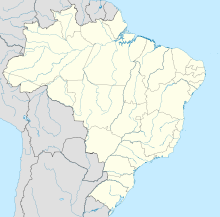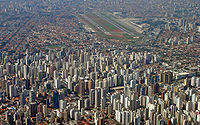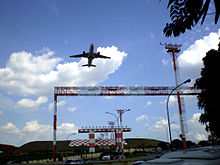- Congonhas-São Paulo Airport
-
São Paulo/Congonhas Airport
Aeroporto de São Paulo/Congonhas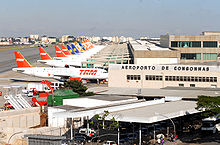
IATA: CGH – ICAO: SBSP Summary Airport type Public Operator Infraero Serves São Paulo Hub for - Avianca Brazil
- Gol Airlines
- TAM Airlines
Elevation AMSL 802 m / 2,631 ft Coordinates 23°37′40″S 046°39′15″W / 23.62778°S 46.65417°WCoordinates: 23°37′40″S 046°39′15″W / 23.62778°S 46.65417°W Website Map Location in Brazil Runways Direction Length Surface m ft 17R/35L 1,940 6,365 Asphalt 17L/35R 1,435 4,708 Asphalt Statistics (2010) Passengers 15,481,370 Aircraft Operations 204,961 Metric tonnes of cargo 23,963 Statistics: Infraero[1]
Sources: Airport Website[2]Congonhas/São Paulo Airport (IATA: CGH, ICAO: SBSP) is one of the three commercial airports serving São Paulo, Brazil. The airport is named after the neighborhood where it is located, formerly called Vila Congonhas, property of the descendants of Lucas Antônio Monteiro de Barros (1767–1851), Viscount of Congonhas do Campo, first president of the Province of São Paulo after the independence of Brazil in 1822, during the Empire. Congonhas, in turn, is the name of the shrub Congonha-do-campo (Luxemburgia polyandra, of the Ochnaceae family).[3]
In 2010, the airport was ranked 2nd in terms of transported passengers and aircraft operations in Brazil, placing it amongst the busiest airports in the country.
It is owned by the City of São Paulo and operated by Infraero.
Congonhas has slot restrictions operating with a maximum of 30 operations/hour, being one of the three airports with such restrictions in Brazil.[4]
Contents
History
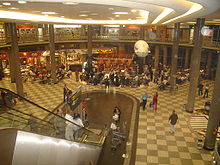 The classic but highly modified Modern architecture central passenger terminal hall at Congonhas airport
The classic but highly modified Modern architecture central passenger terminal hall at Congonhas airport
The airport was initially planned in 1919, but it did not open until 12 September 1936. In the beginning it was the private airport of VASP, built as an alternative to Campo de Marte which, already at that time, had operational difficulties. By 1957, the airport was the third busiest in the world for air cargo.[3]
On 21 May 1959, a formal agreement between Varig, Cruzeiro do Sul and VASP created the shuttle service, which made the airport famous, being the first of its kind in the world. Baptized as Air Bridge (Portuguese: Ponte aérea) and inspired on the Berlin Airlift, the first flight was operated on 6 July 1959. This service operated between Rio de Janeiro-Santos Dumont and Congonhas Airports and comprised regular hourly departures, a common check-in counter and simplified tickets and formalities.[5] The service was an instant success. Sadia joined the partnership in 1968. In 1999 the service was discontinued, as airlines decided to operate their own independent services.[6]
Until 1985 Congonhas was the main airport of São Paulo operating domestic and international flights to neighbouring countries such as Argentina, Uruguay, Paraguay and Bolivia. Intercontinental flights required changing planes at Rio de Janeiro-Galeão or were operated at Viracopos airports. However, the distant location of the latter, in Campinas, 100 km (62 mi) from downtown São Paulo, made this choice inconvenient for passengers and airlines, so the earlier option was preferred.
However, since the opening of Guarulhos Airport in 1985, international flights are no longer operated at Congonhas and domestic operations underwent restrictions. Even so, Congonhas remains important to the city for regional and short-distance domestic flights. Given the concentration of Brazil's economy in the Central-Southern region, where São Paulo is located, such flights make up the greatest share of the country's domestic air traffic. Therefore, even after Guarulhos International Airport was opened, Congonhas continued to face congestion problems, regarding both the number of passengers and the number of flight operations. On ther other hand, its short distance from downtown and from the major business areas of Paulista, Faria Lima and Luís Carlos Berrini avenues still makes Congonhas a favorite of passengers, especially business travelers.
The airport administrator Infraero started in 2003 a comprehensive renovation plan of the airport complex: a remodeling of departure and arrival halls with installation of 12 jetways was completed on 15 August 2004; in December 2005 a new parking garage was opened; the runways received new surface between February and September 2007. They however cannot be extended because of the sheer urban growth of São Paulo, which has completely surrounded and engulfed the airport. Indeed, the view from the landing approach to Congonhas can be spectacular, with aircraft flying very low over massive clusters of tall skyscrapers, especially when approaching from the north.
The airport has been troubled by slippery runways and has had several accidents where water accumulation has been a significant factor, being the most notable the one involving TAM Airlines Flight 3054 on 17 July 2007: although the main runway had been repaved in June 2007, its new rainwater drainage grooves were only finished in September 2007. As a consequence to this accident and the subsequent public outcry for more safety and reduction of noise, the airport has had its operations significantly altered, through the reduction of landing slots, restrictions on flight distance, and of operating times, presently from 6:00 to 22:30 hours. Furthermore, the maximum allowable gross weight of aircraft was reduced.
The largest aircraft now operating at Congonhas are the Airbus A320, Boeing 737–800 and the Fokker 100. However, in the past the airport used to have operations with Boeing 767–200[7] and Airbus A300, by the now-defunct airlines Transbrasil, VASP and Cruzeiro do Sul.
In 2008 Congonhas lost its international category.[3]
The central hall of the passenger terminal is considered one of the most outstanding examples of modern architecture in São Paulo. However, modernizing and enlargement works conducted at the terminal from 2003 onwards, while trying to preserve the look of the older, historic section, still made the latter lose much of its former character. Today the main terminal has 51,535 m2 (554,718 sq.ft.).[3]
Airlines and destinations
Airlines Destinations Avianca Brazil Belo Horizonte-Confins, Brasília, Chapecó, Florianópolis, Rio de Janeiro-Santos Dumont Azul Brazilian Airlines Porto Seguro Gol Airlines Bauru/Arealva, Belém-Val de Cães, Belo Horizonte-Confins, Brasília, Campo Grande, Caxias do Sul, Chapecó, Cuiabá, Curitiba-Afonso Pena, Florianópolis, Fortaleza, Goiânia, Ilhéus, Joinville, Londrina, Macapá, Maringá, Montes Claros, Natal, Navegantes, Palmas, Porto Alegre, Presidente Prudente, Recife, Rio de Janeiro-Galeão, Rio de Janeiro-Santos Dumont, Salvador da Bahia, Uberlândia, Vitória NHT Linhas Aéreas Curitiba-Afonso Pena TAM Airlines Belém-Val de Cães, Belo Horizonte-Confins, Brasília, Campo Grande, Cuiabá, Curitiba-Afonso Pena, Florianópolis, Fortaleza, Goiânia, Ilhéus, Joinville, Londrina, Macapá, Natal, Navegantes, Porto Alegre, Porto Seguro, Recife, Ribeirão Preto, Rio de Janeiro-Galeão, Rio de Janeiro-Santos Dumont, Salvador da Bahia, São José do Rio Preto, Uberlândia, Una/Comandatuba, Vitória TAM Airlines operated by Pantanal Linhas Aéreas Belo Horizonte-Confins, Brasília, Cuiabá, Curitiba-Afonso Pena, João Pessoa, Porto Alegre, Ribeirão Preto, Rio de Janeiro-Galeão, Salvador da Bahia, São José do Rio Preto Webjet Rio de Janeiro-Santos Dumont Accidents and incidents
Major accidents involving fatalities
- 27 August 1943: a VASP Junkers Ju-52/3mg3e registration PP-SPD, flying from Rio de Janeiro-Santos Dumont to São Paulo-Congonhas struck a building of the Naval Academy located close to the airport shortly after take-off under fog. The aircraft broke in two and one part fell in the water. Of the 21 passengers and crew, 3 survived.[8]
- 31 August 1944: a Panair do Brasil Lockheed Model 18 Lodestar registration PP-PBI crashed while on night approach to São Paulo-Congonhas. All 18 occupants died.[9]
- 13 March 1948: a Cruzeiro do Sul Douglas C-53D-DO registration PP-CBX flying to São Paulo-Congonhas crashed on Cantareira Range, near São Paulo. All 6 passengers and crew aboard died.[10]
- 2 August 1949: a Varig Curtiss C-46AD-10-CU Commando registration PP-VBI operating a flight from São Paulo-Congonhas to Porto Alegre made an emergency landing on rough terrain near the location of Jaquirana, approximatelly 20 minutes before landing in Porto Alegre, following fire on the cargo hold. Of the 36 passenger and crew aboard, 5 died.[11]
- 8 September 1951: a VASP Douglas C-47B-20-DK registration PP-SPQ struck a house after take-off from São Paulo-Congonhas and crashed. Thirteen passengers and crew and three persons on the ground died.[12]
- 13 May 1952: a VASP Douglas C-47B-45-DK registration PP-SPM operating a flight from São Paulo-Congonhas to Bauru lost control when carrying out an emergency landing following an engine failure. Two crew members and 3 passengers died.[13]
- 17 June 1953: a Panair do Brasil Lockheed L-049 Constellation registration PP-PDA crashed on final approach to São Paulo-Congonhas. Apparently causes are related to night operations with little visibility. All 17 passengers and crew died.[14]
- 4 June 1954: a Varig Curtiss C-46A-45-CU Commando registration PP-VBZ operating a cargo flight between São Paulo-Congonhas and Porto Alegre crashed during take-off from São Paulo. All crew of 3 died.[15]
- 12 September 1954: a Cruzeiro do Sul Douglas C-47A-70-DL registration PP-CDJ flying from Rio de Janeiro-Santos Dumont to São Paulo-Congonhas was forced to return to Rio de Janeiro due to technical problems and bad weather at São Paulo. On finals to Rio de Janeiro the aircraft came in too high. An overshoot was attempted but the aircraft descended and crashed into the Guanabara Bay. Six passengers out of 30 occupants died.[16]
- 10 April 1957: a Transportes Aéreos Nacional Douglas DC-3/C-47 operated by Real Transportes Aéreos registration PP-ANX, en route from Rio de Janeiro-Santos Dumont to São Paulo-Congonhas crashed into a mountain over the location of Ubatuba. The no. 2 engine caught fire, which forced the crew to make an emergency descent for Ubatuba. Due to rain, the crew noticed Papagaio Peak on Anchieta Island too late. The aircraft stalled during the evasive manoeuvre and crashed into the mountain. Of the 30 passengers and crew aboard, 26 died.[17]
- 30 December 1958: a VASP Saab Scandia 90A-1 registration PP-SQE flying from Rio de Janeiro-Santos Dumont to São Paulo-Congonhas, during climb after take-off had a failure on engine no. 1. The pilot initiated procedures to return to the airport but during the second turn the aircraft stalled and crashed into Guanabara Bay. Of the 37 passengers and crew aboard, 21 died.[18]
- 23 September 1959: a VASP Saab Scandia 90A-1 registration PP-SQV en route from São Paulo-Congonhas to Rio de Janeiro-Santos Dumont during climb after take-off did not gain enough height and crashed 1 1/2 minutes out of São Paulo killing all 20 passengers and crew.[19]
- 26 November 1962: a VASP Saab Scandia 90A-1 registration PP-SRA en route from São Paulo-Congonhas to Rio de Janeiro-Santos Dumont collided in the air over the Municipality of Paraibuna, State of São Paulo with a private Cessna 310 registration PT-BRQ en route from Rio de Janeiro-Santos Dumont to São Paulo-Campo de Marte. Both were flying on the same airway AB-6 in opposite directions and failed to have visual contact. The aircraft crashed killing all 23 passengers and crew of the Saab and 4 occupants of the Cessna.[20]
- 15 January 1963: a Cruzeiro do Sul Convair 240-D registration PP-CEV on initial climb from São Paulo-Congonhas crashed into houses after an engine failed. Of the 45 passengers and crew aboard, 6 died. Six persons on the ground were also killed.[21]
- 3 May 1963: a Cruzeiro do Sul Convair 340-59 registration PP-CDW flying from São Paulo-Congonhas to Rio de Janeiro-Santos Dumont had to return to São Paulo after no. 2 engine caught fire. When on finals to touch down, the aircraft nosed up 45°, stalled and struck a house. Of the 50 passengers and crew aboard, 37 died.[22]
- 3 November 1967: a Sadia Handley Page Dart Herald 214 registration PP-SDJ flying from São Paulo-Congonhas to Curitiba-Afonso Pena collided with a hill during approach to land at Curitiba. All crew and 21 passengers died, 4 passengers survived.[23]
- 12 April 1972: a VASP NAMC YS-11A-211 registration PP-SMI flying from São Paulo-Congonhas to Rio de Janeiro-Santos Dumont flew into the side of a mountain while on descent 50km north of Rio de Janeiro due to pilot mistake. All 25 passengers and crew died.[24]
- 27 February 1975: a VASP Embraer EMB 110 Bandeirante registration PP-SBE operating a flight from São Paulo-Congonhas to Bauru crashed after take-off from Congonhas. All 2 crew members and 13 passengers died.[25]
- 8 February 1979: a TAM Airlines Embraer EMB 110 Bandeirante registration PT-SBB operating a flight from Bauru to São Paulo-Congonhas, while on initial climb from Bauru, struck trees and crashed into flames. All 2 crew and 16 passengers died.[26]
- 12 April 1980: a Transbrasil Boeing 727-27C registration PT-TYS operating flight 303 from São Paulo-Congonhas to Florianópolis was on a night instrumental approach to Florianópolis under a severe thunderstorm. The aircraft went off course, struck a hill and exploded. Probable causes are misjudgment of speed and distance, inadequate flight supervision, failure to initiate a go-around and improper operation of the engines. Of the 58 passengers and crew aboard, 3 passengers survived.[27]
- 12 February 1990: a TAM Airlines Fokker F27 registration PT-LCG operating a flight from São Paulo-Congonhas to Bauru, due to faulty approach procedures touched down at Bauru 775m past the runway threshold. The pilot was unable to initiate a go around procedure and went past the end of the runway hitting a car that was passing on a road nearby. One crew member and 2 occupants of the car died.[28]
- 31 October 1996: a TAM Airlines Fokker 100 registration PT-MRK and operating flight 402 from São Paulo-Congonhas to Rio de Janeiro-Santos Dumont crashed on urban area during take-off procedures and after engine no.2 suffering an uncommanded reverse thrust and thus losing power, stalled, yawed to the right and struck a building. All 95 passengers and crew on board and 4 people on the ground died.[29]
- 9 July 1997: a TAM Airlines Fokker 100 registration PT-WHK operating flight 283 en route from São José dos Campos to São Paulo-Congonhas was climbing after take-off from São José dos Campos when a bomb exploded in the rear part of the passenger cabin. The uncontrolled decompression blew one passenger out of the aircraft. The aircraft made a successful emergency landing in São Paulo, despite the hole in the fuselage.[30]
- 17 July 2007: a TAM Airlines Airbus A320 registration PR-MBK operating flight 3054 from Porto Alegre to São Paulo-Congonhas overran the runway while landing at Congonhas, crossed a major thoroughfare and impacted against a TAM Express warehouse. All 186 passengers and crew perished. 199 bodies were recovered from the crash site, including passengers, crew and people that were working at the warehourse.[31]
Incidents
- 30 May 1972: a Varig Lockheed L-188 Electra registration PP-VJL operating a flight between São Paulo-Congonhas and Porto Alegre was hijacked. The hijacker demanded money. The aircraft was stormed and the hijacker shot.[32]
Access
The airport is located 8 km (5 mi) from downtown São Paulo, at Washington Luís Avenue, in the district of Campo Belo.
Azul Brazilian Airlines offers for its passengers free bus transfers between Congonhas and Campinas-Viracopos International Airport at regular times.[33]
Gol Airlines and TAM Airlines offer for their passengers free bus transfers between Congonhas and Guarulhos/Gov. André Franco Montoro Airport airports at regular times.[34][35]
Further bus transportation is also available through the Airport Bus Service, an executive bus line, administered by EMTU and operated by Consórcio Internorte – Área 3. This service provides transportation between Guarulhos and Congonhas airports, via Tietê Bus Terminal, Palmeiras-Barra Funda Intermodal Terminal, Itaim Bibi, Praça da República, Tatuapé Metro Station and the circuit of hotels along Avenida Paulista and Rua Augusta. The ride takes about one hour, depending on traffic.[36]
Future developments
On 31 August 2009, Infraero unveiled a BRL164.7 million (USD86.8 million; EUR60.8 million) investment plan to up-grade Congonhas Airport focusing on the preparations for the 2014 FIFA World Cup which will be held in Brazil, São Paulo being one of the venue cities. The investiment will be distributed as follows:[37]
- New control tower. Value 11.9. Completion: January 2010 (work not yet completed in August 2011)
- Renovation of the apron. Value 20.6. Completion: January 2012
- Conclusion of the renovation on the south portion of the passenger terminal. Value 67.1. Completion: October 2012
- Renovation of the north portion of the passenger terminal. Value 65.1. Completion: October 2014
See also
References
- ^ Infraero Statistics for the Airport
- ^ Airport Official Website
- ^ a b c d "Aeroporto de Congonhas: Histórico" (in Portuguese). Infraero. http://www.infraero.com.br/index.php/br/aeroportos/sao-paulo/aeroporto-de-sao-paulo--congonhas/historico.html. Retrieved 4 August 2011.
- ^ "Procedimento de alocação de slots disponíveis" (in Portuguese). ANAC. http://www2.anac.gov.br/arquivos/pdf/Slots%20CGH.pdf. Retrieved 3 August 2011.
- ^ Beting, Gianfranco; Beting, Joelmir (2009) (in Portuguese). Varig: Eterna Pioneira. Porto Alegre and São Paulo: EDIPUCRS and Beting Books. pp. 83–84. ISBN 978-85-7430-901-9.
- ^ "Ponte Aérea completa meio século" (in Portuguese). Revista da Associação dos tripulantes da TAM: pp. 2–3. 2009.
- ^ Transbrasil Boeing 767. Boeing 767, o primeiro do Brasil (video). São Paulo, Brazil: YouTube. http://www.youtube.com/watch?v=16BCIVYsQWI. Retrieved 23 July 2007.
- ^ "Accident description PP-SPD". Aviation Safety Network. http://aviation-safety.net/database/record.php?id=19430827-0. Retrieved 17 August 2011.
- ^ "Accident description PP-PBI". Aviation Safety Network. http://aviation-safety.net/database/record.php?id=19440831-0. Retrieved 17 August 2011.
- ^ "Accident description PP-CBX". Aviation Safety Network. http://aviation-safety.net/database/record.php?id=19480313-0. Retrieved 17 August 2011.
- ^ "Accident description PP-VBI". Aviation Safety Network. http://aviation-safety.net/database/record.php?id=19490802-0. Retrieved 15 August 2011.
- ^ "Accident description PP-SPQ". Aviation Safety Network. http://aviation-safety.net/database/record.php?id=19510908-0. Retrieved 18 August 2011.
- ^ "Accident description PP-SPM". Aviation Safety Network. http://aviation-safety.net/database/record.php?id=19520513-0. Retrieved 20 May 2011.
- ^ "Accident description PP-PDA". Aviation Safety Network. http://aviation-safety.net/database/record.php?id=19530617-1. Retrieved 17 August 2011.
- ^ "Accident description PP-VBZ". Aviation Safety Network. http://aviation-safety.net/database/record.php?id=19540604-0. Retrieved 16 August 2011.
- ^ "Accident description PP-CDJ". Aviation Safety Network. http://aviation-safety.net/database/record.php?id=19540912-0. Retrieved 18 August 2011.
- ^ "Accident description PP-ANX". Aviation Safety Network. http://aviation-safety.net/database/record.php?id=19570410-2. Retrieved 17 August 2011.
- ^ "Accident description PP-SQE". Aviation Safety Network. http://aviation-safety.net/database/record.php?id=19581230-0. Retrieved 17 August 2011.
- ^ "Accident description PP-SQV". Aviation Safety Network. http://aviation-safety.net/database/record.php?id=19590923-1. Retrieved 18 August 2011.
- ^ "Accident description PP-SRA and PT-BRQ". Aviation Safety Network. http://aviation-safety.net/database/record.php?id=19621126-1. Retrieved 2 June 2011.
- ^ "Accident description PP-CEV". Aviation Safety Network. http://aviation-safety.net/database/record.php?id=19630115-1. Retrieved 17 August 2011.
- ^ "Accident description PP-CDW". Aviation Safety Network. http://aviation-safety.net/database/record.php?id=19630503-0. Retrieved 17 August 2011.
- ^ "Accident description PP-SDJ". Aviation Safety Network. http://aviation-safety.net/database/record.php?id=19671103-0. Retrieved 6 May 2011.
- ^ "Accident description PP-SMI". Aviation Safety Network. http://aviation-safety.net/database/record.php?id=19720412-0. Retrieved 18 August 2011.
- ^ "Accident description PP-SBE". Aviation Safety Network. http://aviation-safety.net/database/record.php?id=19750227-1. Retrieved 20 May 2011.
- ^ "Accident description PT-SBB". Aviation Safety Network. http://aviation-safety.net/database/record.php?id=19790208-0. Retrieved 20 May 2011.
- ^ "Accident description PT-TYS". Aviation Safety Network. http://aviation-safety.net/database/record.php?id=19800412-0. Retrieved 22 July 2011.
- ^ "Accident description PT-LCG". Aviation Safety Network. http://aviation-safety.net/database/record.php?id=19900212-0. Retrieved 20 May 2011.
- ^ "Accident description PT-MRK". Aviation Safety Network. http://aviation-safety.net/database/record.php?id=19961031-0. Retrieved 17 August 2011.
- ^ "Accident description PT-WHK". Aviation Safety Network. http://aviation-safety.net/database/record.php?id=19970709-1. Retrieved 13 August 2011.
- ^ "Accident description PR-MBK". Aviation Safety Network. http://aviation-safety.net/database/record.php?id=20070717-0. Retrieved 16 July 2011.
- ^ "Incident description PP-VJL". Aviation Safety Network. http://aviation-safety.net/database/record.php?id=19720530-1. Retrieved 16 August 2011.
- ^ "Ônibus Executivo/Congonhas-Aeroporto de Viracopos". Azul Brazilian Airlines. http://www.voeazul.com.br/aspx/servicoOnibusCongonhas.aspx. Retrieved 27 March 2011.
- ^ "Transporte para aeroportos" (in Portuguese). Gol Airlines. http://www.voegol.com.br/pt-br/servicos/transporte-para-aeroportos/paginas/default.aspx. Retrieved 30 August 2011.
- ^ "Traslados Nacionais". TAM Airlines. http://www.tam.com.br/b2c/vgn/v/index.jsp?vgnextoid=5ef993f30bb2d210VgnVCM1000009508020aRCRD. Retrieved 27 March 2011.
- ^ "Sistema Aeroporto" (in Portuguese). EMTU. http://www.emtu.sp.gov.br/aeroporto/. Retrieved 4 August 2011.
- ^ Rittner, Daniel; Braga, Paulo Victor (31 August 2009). "Infraero vai gastar R$5 bi em reforma de aeroportos" (in Portuguese). Valor Econômico: pp. A4. http://www.valoronline.com.br.
External links
- Airport information for SBSP at World Aero Data. Data current as of October 2006.Source: DAFIF.
- Airport information for SBSP at Great Circle Mapper. Source: DAFIF (effective Oct. 2006).
- Current weather for SBSP at NOAA/NWS
- Accident history for CGH at Aviation Safety Network
- Congonhas Airport Photo Archive at airliners.net
Lists of airports By IATA code - A
- B
- C
- D
- E
- F
- G
- H
- I
- J
- K
- L
- M
- N
- O
- P
- Q
- R
- S
- T
- U
- V
- W
- X
- Y
- Z
By ICAO code - A
- B
- C
- D
- E
- F
- G
- H
- I
- J
- K
- L
- M
- N
- O
- P
- Q
- R
- S
- T
- U
- V
- W
- X
- Y
- Z
By traffic Other lists - Airports by country
- Airport eponyms
- Airline destinations
- Military installations
 Brazil
BrazilHistory First inhabitants · Colonization · Empire · Old Republic · Vargas Era · Second Republic · Military rule · ContemporaryGeography Regions · States · Mesoregions · Microregions · Municipalities · Islands · Coastline · Climate · Environment · Extreme points · Protected areas · CapitalsGovernment Constitution · Federal government · President · National Congress · Foreign relations · Law · Law enforcement · MilitaryPolitics Economy Society Demographics · People · Languages · Religion · Immigration · Education · Health · Crime · Social issues · Largest cities · ApartheidCulture Commuter Rail Line 7 (Ruby) • Line 8 (Diamond) • Line 9 (Emerald) • Line 10 (Turquoise) • Line 11 (Coral) • Line 12 (Sapphire) • Line 13 (Jade) • Line 14 (Onyx)
Metro
(List of stations)Line 1 (Blue) • Line 2 (Green) • Line 3 (Red) • Line 4 (Yellow) • Line 5 (Lilac) • Line 6 (Orange) • Line 15 (White) • Line 16 (Silver) • Line 17 (Gold)Bus Lines SPTrans • Empresa Metropolitana de Transportes Urbanos de São Paulo (EMTU) • Expresso Tiradentes • Trolleybuses in São PauloAirports São Paulo-Guarulhos International Airport • Congonhas-São Paulo Airport • Campo de Marte AirportBus Terminals Tietê Bus Terminal • Jabaquara Intermunicipal Terminal • Lapa TerminalIntermodal Terminals Sacomã Terminal • Luz Station • Palmeiras-Barra Funda TerminalCategories:- Airports in Brazil
- Airports established in 1936
- Airports in São Paulo (state)
- Transport in São Paulo (city)
- Buildings and structures in São Paulo (city)
Wikimedia Foundation. 2010.

